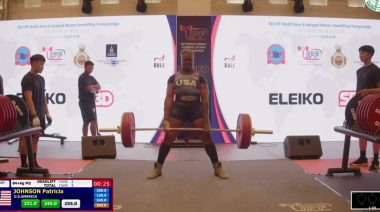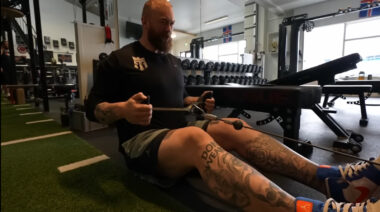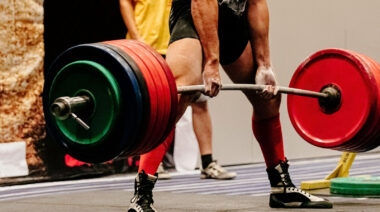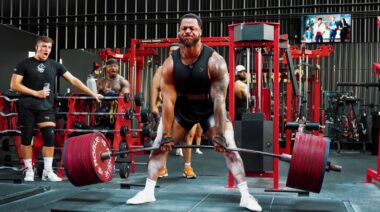Nick Weite (pronounced “white”) is currently a world-class powerlifter and commissioned police officer with the St. Louis Missouri Metropolitan Police Department.
?
Tom: Tell the readers about your accomplishments in the sport of powerlifting.
Nick: I have won three United States Powerlifting (USAPL) Open National Titles, competed in the International Powerlifting Federation (IPF) Open Worlds three times (with a second place finish being my highest placing), and competed in the World Games (highest competition a powerlifter can compete in). I hold the USAPL American Record for total with a 2,336lb total in the 275lb class, and I have won several competitions at the Arnold Schwarzenegger Classic, including the Raw Challenge and the Pro Deadlift. My best lifts to date include a 903lb squat, a 600lb bench, and an 859lb deadlift. ??
Tom: You are obviously a strong man. Aside from your good genetics and hard training, what other factors have led to your success?
Nick: Being consistent in the pursuit of getting stronger. Becoming stronger doesn’t happen over night. It takes years of getting on a solid program, forming a great group of training partners, seeking advice from better lifters, and the biggest thing – not missing workouts. I am also a believer of setting goals, both short term and long term, then mapping out what needs to happen to reach them. While finding a solid program that works for you is critical, a good program alone is not sufficient. It’s what you put into that program that produces results. ?? ??
Tom: Technique in the bench press, squat, and?deadlift?are obviously paramount in your preparation. Is there a certain ratio of strength training versus technique training that you would recommend to others??
Nick: I wouldn’t say there’s a certain ratio, but you must have a good base of solid technique before you can make great strength gains. I started off my lifting career really focusing on my technique before adding any weight. Now, I focus more on the strength aspect, as my technique is second nature. I feel that if you don’t have proper technique in any of the lifts, your strength gains will only go so far. My advice is to go find a gym with a good group of guys and learn as much as you can from the veteran lifters.
Tom: What general nutritional advice you can offer the aspiring powerlifters out there?
Nick: Obviously?you need to have your nutrition on point in order to get stronger. You have to fuel your body with the proper amount of carbs, proteins, and fats to make sure you’re?fully energized and recovering properly. Determining these nutritional guidelines can be a challenge because not only is each individual different, but their needs change over time as activity levels, training cycles, muscle mass, and metabolism changes. I recommend consulting a nutrition coach who has worked with powerlifters. That can be very helpful.
“I am also a believer of setting goals, both short term and long term, then mapping out what needs to happen to reach them.“
My general advice is to make sure to get at least a gram of protein per lean body pound and use carbs before and after your workouts to provide fuel and recovery. Finally, getting enough of the right kind of fat is critical for fat burning and energy maintenance.
Powerlifters are often trying to gain weight to fill a class or lose weight to make a lower weight class. I usually fall into the latter category, losing anywhere from ten to twenty pounds before a meet. I do so by following a ketogenic diet. Several weeks before I start a training cycle for a meet, I cut my carbs completely and do nothing but fats and proteins during the week, then have a one-night carb re-feed. I try to get my weight within my weight class about five weeks prior, then I start adding more carbs around my workouts. This method may not work for everyone, but it allows me to keep my strength levels up while losing weight.
Tom: I know your training sessions are demanding. Can you speak to the importance of recovery time between training sessions
Nick: I have trained four days a week since 2007 (my first full year of competing) and currently train on Monday, Wednesday, Friday, and Saturday. This is spaced out to allow enough time to recover before pushing myself in the next workout. Spacing of workouts is just one step in the recovery process.
The best two recovery tools are sleep and nutrition. Getting an average of seven hours of sleep per night, if not more, is a must. While you sleep, growth hormone is released and your body goes to work repairing your muscles. Without sleep, cortisol levels can rise and testosterone is lowered – not the route I want to go.
Nutrition also has to be on target to help the recovery process. If sleep and nutrition are lacking, no matter how hard you train you won’t get the best results possible.
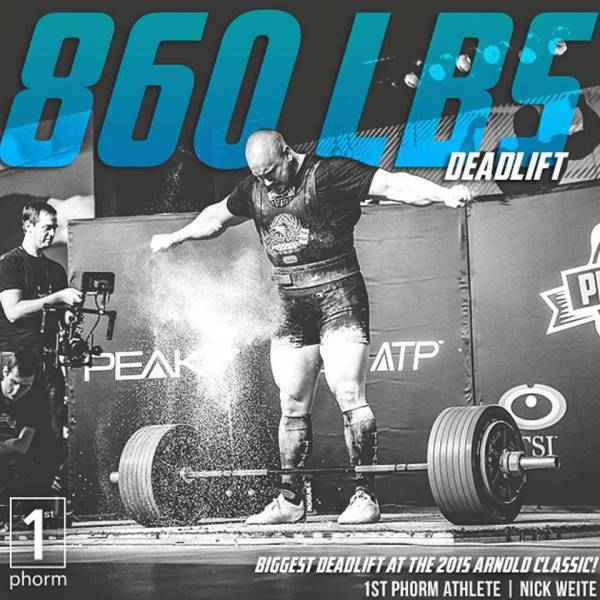
Tom: Any tips on training hard while avoiding becoming injured?
Nick: You have to know your own body and what it can do. Pushing your body to the limit every workout is going to catch up with you. You need to space your training, giving yourself the correct levels of volume and intensity to assure you’re not burning yourself out. Also, if I have a pull or a strain, I need to determine if I’m able to push through it without causing further injury or if I need to pull back and let it recover. That’s where the old saying, “Are you hurt, or are you injured?” enters into the discussion. If you have a strain or an ache, you may be able to train through it, but if you’re injured and you try to train through, it’s only going to make you miss more training time and prevent gains in the long run.
?
Tom: Do you follow a training regimen based on percentages of your 1RM or do you use a different system?
Nick: I trained for several years following a percentage-based program off of my 1RMs, but have switched my training the last several cycles to a customized program from Reactive Training Systems. This program, which is based on RPE (rate of perceived exertion), calls for the athlete to determine how difficult a set was and auto-regulate the volume and weight of successive sets. The RPE is a chart-based number system that starts at the number six and goes through ten. The number reflects how hard the set was. For example, seven means it feels like a warm up and ten reflects a max-effort lift. After each session, I log my workout into a spreadsheet that calculates my 1RM based on the weight lifted and RPE.
“You have to know your own body and what it can do. Pushing your body to the limit every workout is going to catch up with you.“
Tom: You are a busy man as a full-time police officer, husband, and father. How do you find time to train with those other commitments in your life?
Nick: It’s all about planning and commitment. If I am committing to a meet, my life is planned around my training. I get in quality workouts and refuse to just go through the motions to get them in. I am very focused when it comes to my training cycles, at times forgoing leisure or extracurricular activities in order to train. However, I don’t allow my training to interfere with my family or work. My wife is also fully supportive of my competing and makes sacrifices to allow me the time to train.
?
Tom: Nick, thank you for taking the time to respond to these questions. I am sure all?our?powerlifting fans will appreciate your words of advice.
Check out these related articles:

